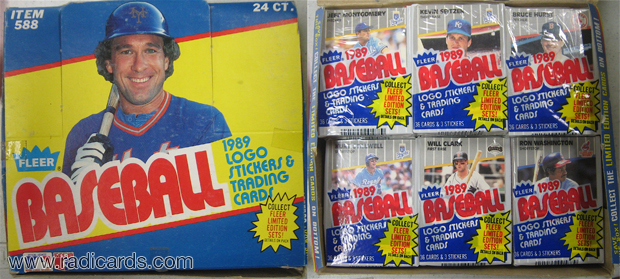
It’s been literally decades since I last broke a box of 1989 Fleer. This was my first go at 1989 Fleer Cello. As a young boy, I remember going to the local hobby shops with my dad and buying packs of these guys. As I’d spend my $2/week allowance, I would always hope to pull either the Ken Griffey Jr.
or the Bill Ripken
. I used to get so excited about the feel of brand new gray and white stripes as I examined each card with all of my senses. To this day, this product is still a fun break and although I already possess multiple copies of each, I still enjoy the search for Griffey and Ripken. When I stumbled upon this box for just a few bucks, I figured it would make for an excellent product review. As you read, you will see that the Cello box is a real bargain for the value it provides. In this analysis, I will discuss the breakdown, rookies, inserts, print spots, box bottoms and errors. I pulled everything you see here. There’s a lot to talk about so let’s have some fun with this!
1989 was a great year for the hobby, with Upper Deck entering the market, things started to look mighty interesting and brands were forced to step up if they wanted to stay in the game (no pun intended). Although ’89 was smack dab in the middle of the over saturation era, it held significance due to a youngster by the name of Ken Griffey Jr. This was his inaugural year out of the gate and sales for his iconic ’89 Upper Deck rookie were really starting to take off. Fleer piggy backed off of Griffey’s popularity and released a more affordable Griffey RC which likely helped drive sales for this product. Aside from the Griffey chase, buyers of ’89 Fleer discovered something else in their stacks of cards. A slight bit of vulgarity on the bat nob of a Bill Ripken. This little discovery drove sales of ’89 Fleer through the roof. The SRP soon followed suit to counter balance the demand. More on this later. Both cards were highly sought after and collected. 21 years later, things haven’t changed much. Collectors still chase Griffey and Ripken in this product and each are still highly coveted. With so many variations of the Ripken error on the market, this product still continues to spark interested among hobby enthusiasts.
Breakdown:
Let’s get to business. The Cello Box is made up of 24 packs, each pack containing 36 cards and 3 stickers.
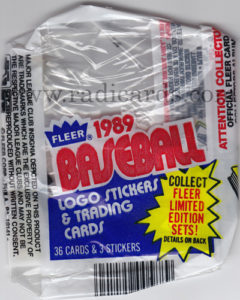
The math comes to 864 cards and 72 stickers. However, after collating and counting, I actually pulled 875 cards out of this box. A complete set consists of 660 cards. Let’s look at the breakdown:
- 657/660 base cards: % of set complete = 99.54%
- Duplicates: 212
- 6/12 1989 Fleer All-Star Team: % of set complete = 50%
Although there were many duplicates, it’s expected with any product from this year due to the saturated production run. The upside is that I am only 3 cards short of a full set after opening only one Cello box! This is great news for set collectors. Additionally, this also gives the buyer over a 99% chance of pulling Griffey and/or Ripken. I was fairly impressed by the sheer amount of product you get for the bargain price for this product. The low at $5/box, the high at $11/box. Either way, it’s a deal given the odds of pulling our two guys. At the time I write this, the Griffey is worth $10 and the Ripken variations range from $5-120 depending on which variation you pull. Finally, there are two other lesser known but fun errors that can be found behind this plastic. The Randy Johnson RC w/ Marlboro sign in the background and the Jeff Treadway card with the target over his head, both more desirable than their more common intended-release counterparts. These are surprisingly tough cards to pull. I didn’t pull either one of those errors but I did manage to snag each of the main rookies from ’89.
Rookies:

These are the main rookies within this product. Each of these guys have experienced stellar careers and achieved incredible field numbers. These 5 guys will likely meet again on the walls of Cooperstown. The one upside of the saturation era is how available and affordable it made rookie cards. I’ve paid as little as $0.25 and as high as $2 for these cards and that’s a bargain for a rookie card of a future hall of famer. Can’t beat a Griffey rookie for $2!
Related article: 1989 Fleer Cello: Beating the Odds
Inserts:
Moving on, this product boasts an insert set appropriately titled, 1989 Fleer All-Star Team. It’s a 12 card set featuring the big names of the year. I pulled 8 of these but only 6 unique.
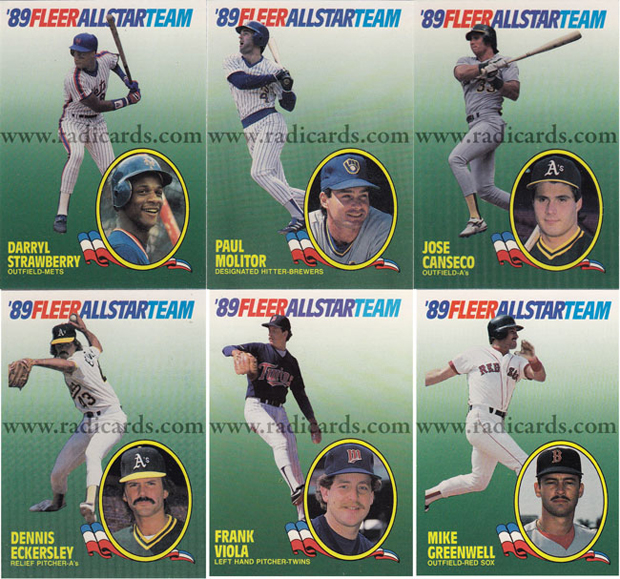
Ahh, the early years of insert cards. I actually like this design. It kinda reminds me of 1983 Topps. I think it’s the player portraits that are responsible for my nostalgia. I also like the green to white gradient. That’s a nice change when you are busting well over 800 cards with gray and white stripes. These inserts add a little color to the break which is something refreshing. A personal note, I always thought Dennis Eckersley looked a lot like the Mediterranean mega pop sensation, Yanni. Maybe it’s the long brown hair and magnum p.i. stache. Either way, it cracks me up and it’s all the more reason to like Dennis.
Box Bottoms:
What I always liked about 80’s product is that often times, boxes were coupled with what are known as Box Bottoms. These cards were printed on the bottoms of the box at a rate of 4, sometimes 6 cards. I can remember having fun cutting them out and adding them to my binders as a kid. I can also remember comparing the different pictures with that of the players base care from the set. Here’s what was found on the bottom of this box along with their base card counterpart for your comparison:
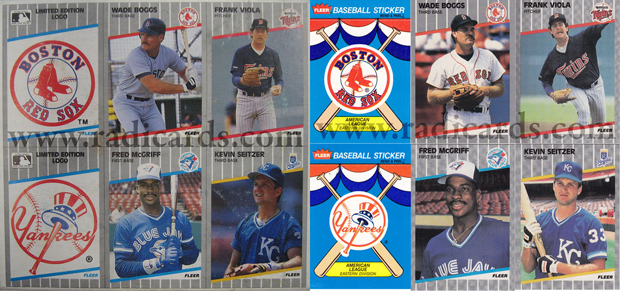
Print Spots:
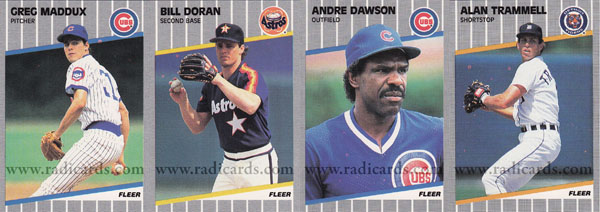
Sports card manufacturing, much like any manufacturing, possesses some probability of defects. With massive production runs, it’s no wonder that some cards came off the press sprinkled with print spots. This was very common up until well into the 90’s. You don’t see this as often in today’s market due to technological advancements in quality control. However, the 80’s experienced its fair share of print spots. I’ve seen ’em pretty abundant in some products and ’89 Fleer is no exception. Each of the above cards shows significant spotting. This type of defect doesn’t help influence secondary value, in fact, in some cases (all), it significantly decreases the cards value. I actually think the spots on these ’89 Fleer are pretty interesting because they are hot pink. I usually see print spots that are from relatively the same color spectrum as a color used on the card. That isn’t the case here and that’s why I thought them to be somewhat amusing.
Errors:
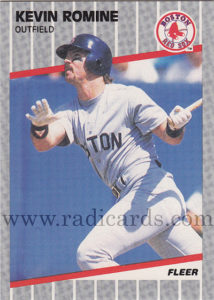
This box was rich with variety given the volume of cards. Among them were some rather interesting factory misprints and errors. During the 80’s there was apparently a lot of confusion on spelling and understanding with where these players live(d). I’m not going to focus too much on that as much as the main errors such as picture swaps, typo’s, and vulgarities. With that said, here is a look at what was found in this box.
We’ll start this discussion off with a the Kevin Romine card. The real estate on this card should feature Kevin Romine with his arms folded but instead depicts Randy Kutcher batting. I thought this was kinda fun, unfortunately I didn’t pull the corrected variation for a nice comparison. This one will have to suffice.
Related article: Jeff Treadway 1989 Fleer #173 Variation Comparison
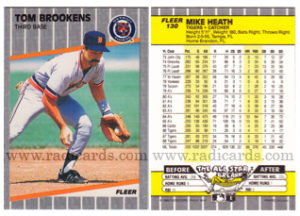
Another known error is that of Mike Heath and Tom Brookens. Both of these guys traded fronts of each other’s cards. They have each others backs. Card #130, Tom Brookens on the front, Mike Heath on the back. Knowing how often this took place in Topps products from the 80’s, I kept my eyes peeled for more cards like this but these were the only two players with this error in this box.
In contrast to card #130, card #132 features Mike Heath on the front and Tom Brookens on the back. Corrections do exist but are worth 5x less than the errors. Current book values for this error is a whopping $0.25. Cost aside, it’s a pretty novel experience to flip a card over and see the wrong back/front. I like it because it’s something completely unexpected. What makes this error special is that it was an honest manufacturing error. Error’s like this were fairly popular in the 80’s. In a sense, errors were the first chase cards. In today’s market, errors are sometimes intentionally produced to stimulate market demand but this was not the case in the 80’s… or was it?
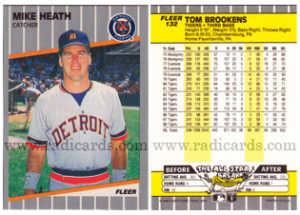
Other errors often found in the ’80’s are typo’s. This was a rampant issue and many times included the misspelling of home towns, last names, team names, and even sometimes words weren’t completely typed out. Here is an example of such an error:
These errors are especially easy to miss if you don’t know what to look for. You’ll notice that each card depicts the player’s dominant batting and throwing arms. Due to space, time constraints or some other reason, each of these guys dominant throwing arms were abbreviated. Ashby throws Rig; Trillo throws Rig…; Vande Berg throws Lef. I’ve never heard of these types of arms before, what’s Rig…? Ha! According to Beckett, these errors are worth $2 each. Got some real investments here!
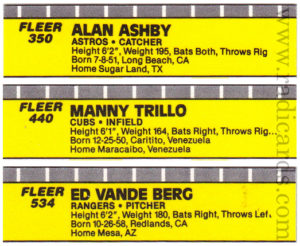
Up until this point, we’ve discussed errors that are relatively common in 80’s product. These mistakes are due to any number of reasons. Perhaps the press sheets got mixed up or the understanding for who’s who was misunderstood or maybe the guy responsible for typing the player info on the backs of each card got fatigued one night after a long 12 hour stretch and just said F*it and quite typing full words. Perhaps this is the same person responsible for the grammatical errors and was tired of getting heat from upper management so just decided to have some fun. Kinda makes you wonder who was in charge over there at Fleer in ’89. Whatever the case, these cards make for a nice chase but non is as famous, vulgar and as continually collected and sought after throughout the hobby as card #616, Bill Ripken. This card is known as the “rick face” error. The title was likely chosen to soften up the potentially offensive nature of this card.
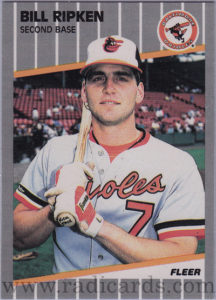
According to an article published by CNBC back in 2008, Billy spoke out and shared the reason behind how this variation occurred. Based on this article, Billy was given a large inventory of the R161 model of Louisville Slugger’s. These bats were too heavy for Bill’s preference but he used one for batting practice anyways. In order to more easily and quickly identify his chosen bat among the remaining inventory, he wrote the phrase F*ck Face on the nob. One day during batting practice after fielding the bases, he was asked to have his picture taken. Without thinking about what he wrote, he grabbed his bat and took the pic, no biggie. Billy didn’t learn about what had happened until the Fleer card was already in circulation. At which point, Fleer tried to fix this little mistake as quickly as possible. It’s not known for sure but some believe that perhaps this release was not an accident from Fleer, and that it was known prior to printing and maybe even enhanced in order to stimulate market demand. Who knows for sure but at the end of the day, I would imagine that Ripken took a lot of heat for this little bit of clubhouse imprecation. Cheer up Bill Ripken, we think you’re pretty rad!
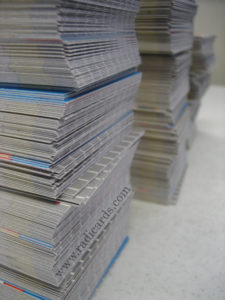
This card sparked some controversy in the collecting world when it was discovered back in 1989. As Fleer tried to quickly fix the mistake with a number of attempted amelioration’s (i.e., black box, scribble, whiteout, etc.), the hobby experienced a brief flux of artificial demand for this card. As the world found out, everyone wanted to see what this card was all about and hence wanted one for themselves. During it’s prime, I’ve heard sales of this card fetching well over $100! That didn’t last long and soon the demand bottomed out and this card now fetches $15. The error variations however, still to this day demand high dollars and some are still incredibly scarce. I still have never seen the whiteout variation in person during my 22 years of collecting. According to secondary market resources, the whiteout is the scarcest of all known versions. So how many variations exist? I’ve heard 6, I’ve also heard 12. I don’t know for sure. Whatever the variation, this card adds to the excitement of breaking a box of 1989 Fleer!
Conclusion:
This break was entertaining to say the least. With all of the classic rookies, inserts, box bottoms and famous errors, it makes for a fun and nostalgic bust. Add to that the set building percentage of 99.54% that comes with a box of 1989 Cello. This is great news for set builders. The only down side is the 212 doubles. With the current going market value for both the Griffey and any variation of the Ripken, the cost for this product is i.m.h.o., worth every penny. So there you have it!
Cheers to 1989 Fleer Cello!

 Visit our store
Visit our store



I did, that exact one! 🙂
So did you pull the f*ck face card? Nice!
Hi Ryan,
Thanks for the complement! Good work on your recent ’89 Fleer buy! If you find some unopened packs, let me know if you pull the Ripken whiteout variation. Cheers!
Great review, Patrick! I just bought the 660 card set off of a craig’s list seller. I’ve only gone through a small portion of the set, but I love it so far. I’m definitely going to try and find some unopened packs of this product. Instant classic!
Hello,
Another rare error from 1989 Fleer that very few are aware of is the checklist card with positions listed. For more info on FF versions, visit http://www.billripken.com. We have some of the versions listed but there’s more….
Hi Donovan,
Love your site! I came across your site about a year ago, extremely impressive work! Great job! 🙂
RE: The 1989 Fleer Whiteout. Were you looking to buy one of for info/pics or ?
I’m interested in owning a copy of the whiteout variation for my self. That card eludes me.
Donovan, I just sent you an email directly inquiring about the bgs 8.5 and the ungraded whiteout.
I tried to find your contact info. I emailed the addy I found when I clicked on your name but it was kicked back. I have a BGS 8.5 Whiteout and a ungraded one that are extras, as I have a PSA 9. My email is info at billripken.com
Be sure to check the checklists as well. If you have one with the players positions listed, VERY rare. I know of only 2.
Happy Hunting
Nice tip, thanks Donovan! 😎
Great job! Especially love the stack of ’89 Fleer pic! Great set, great story.
Thanks Jon! ’89 Fleer baseball is a classic.
I enjoyed your article on 89 fleer. Many fond memories with product. I have a ? I hope you can answer. I recently purchased two cello boxes from local card shop for $10 each. How can you tell if you have the swear card box. The serial #8611 A is im printed on front of box. I had two wax boxes awhile back that both had A series & they had the swear card. I was never sure though if the A meant first run. If someone could tell me I would appreciate it. Thanks, Jay
Hi Jay,
Thanks for checking in. Congrats on your purchase of two cello boxes. I can’t say with any degree of certainty if the serial # is correlated with the swear card. If indeed a correlation exists, I think the logic you’ve posed about series A may be applicable. If you’ve pulled them from series A boxes before, and you pull one from this series A box, that assumption will be strengthened. If you pull one, circle back and let us know. Thanks for reading. 🙂
Why is a comma after Griffey on front missing and the back has a comma after Griffey.. most of his cards have a comma after Griffey And before Jr..Or some don’t have the comma before Junior at all.. but this 1989 Fleer has done correctly on the back but the front is missing the comma but nobody talks about this
If you look around at Ken Griffey Jr. cards from his entire career, you’ll find the comma exists on some but not others. Same goes for Cal Ripken Jr., whose name is sometime printed without the “Jr.” Its commonality is likely why it’s not discussed.